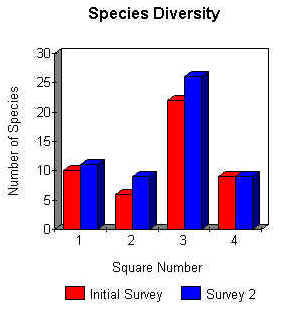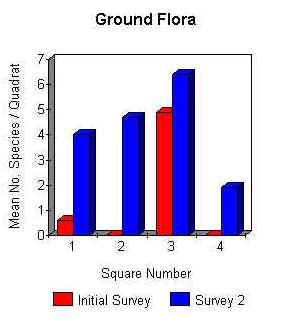Woodland Project Phase 2 Survey Report
RESULTS
General
| The number of species recorded on the Woodland Project
site has increased from 26 (initial survey) to 37 (Table 1).
This represents an increase of 42% in the short space of time that has elapsed since
completion of Rhododendron clearance. The actual number of species on the site may be
higher than that recorded as large numbers of seedlings were present which were as yet too
small and indistinct to allocate to a particular species. It could be argued that this increase in species diversity was merely a consequence of sampling the project site at different times of year : The initial survey was carried out in the depths of winter when no annual plants would be present. (Perennial plants would still be notable at this time of year, because even if they are species which die back for the winter, there are usually dead leaves remaining to point to their presence and to aid identification.) The second survey was carried out in the spring / early summer. At this time of year diversity naturally increases as many new seedlings, particularly those of annual species, appear to take advantage of the short growing season. However, none of the new species found on the project site were annuals. All of them were seedlings of perennial species. This indicates that they were newly colonising the project site and had not previously been present (except as a component of the seed bank in the soil). |
|
Rhododendron clearance has resulted in increased species diversity across all areas of the project site, except in the region of Square 4 (Figure 1). This increase in species diversity has occurred very rapidly, in the short space of time that has elapsed since clearance was completed. (This amounted to less than one month in the areas of Squares 1 and 2). |
Figure
1. |
| Diversity has also continued to increase in Square 3, located in the region cleared in the pilot project nearly three years ago (Figure 1). This region, having had the greatest length of time to regenerate, also had the greatest species diversity, with more than double the number of species recorded in other regions (Figure 1). The most noticeable change in species diversity was in the ground flora. |
|
In the initial survey, ground
flora was totally absent from regions 2, and 4 and virtually absent from region 1(Figure
2). In this second survey, on average, at least four or five different species were found
in each of the quadrats surveyed in regions 1 and 2 (Figure 2). There were less than two species found per quadrat in Area 4, with no overall increase in species diversity (Figures 1 & 2). Although Area 4 was the first to be cleared of Rhododendron, it was the last to be raked and cleared of leaf litter, and so has had less time to regenerate than Areas 1 and 2.
|
Figure 2. |
|
Woodland Project Phase 2 |
||
Results |
||

